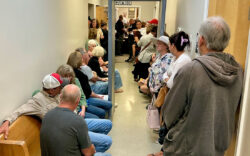The roots of slavery and white supremacy run deep at the University of Georgia, with effects that persist at some level today—that much was clear after a two-day symposium on slavery at UGA and its continuing aftermath. But UGA is also a much better place for Black students today than it was not so long ago, Black students at the symposium said.
The 2021 “History of Slavery at UGA Symposium on Recognition, Reconciliation and Redress” grew out of public furor over the UGA administration’s controversial treatment of the remains of slaves unearthed during a renovation project at UGA’s Baldwin Hall five years ago. An anonymous $100,000 grant funded the beginning of a number of faculty and student research projects, culminating in what organizers hope will be the first such symposium. It brought together an audience of hundreds on Zoom and YouTube Apr. 30 and May 1 to hear about 50 presenters, mainly UGA faculty researchers, university students and alumni, and Athens community members.
Pre-Civil War, slaves did much of the actual work on campus, though records show the university didn’t own slaves. Instead, they rented enslaved African-American men and women.
UGA administrators and faculty owned slaves, however. One university president, Moses Waddell, enslaved at least 16; Andrew Lipscomb had 54—36 male and 18 female, 16 of them under the age of 10, according to historical records. About a third of 76 professors identified owned slaves, including the LeConte brothers, whose name is on the building housing UGA’s history department. Between them, they had 109 slaves.
Thirty of the school’s 38 trustees between 1830 and 1865 were involved in slavery in one way or another; census, property and other records also showed that of 710 identified pre-Civil War alumni, 303 held slaves.
One UGA president, Alonzo Church, fathered a daughter with one of his slaves, one student historical researcher found. UGA product Alexander Stephens, the vice president of the Confederacy, may have as well.
UGA also supplied intellectual support for slavery. The university’s founder, Abraham Baldwin, was a prominent national defender of slavery, though he apparently owned none himself. T.R.R. Cobb, a founder of UGA’s law school, also was a prominent pro-slavery intellectual.
Whites exploited other people of color as well, including controversial treaties that resulted in whites seizing the land that would become UGA and Athens from Native Americans, said UGA history professor Claudio Saunt, whose recent book Unworthy Republic: The Dispossession of Native Americans and the Road to Indian Territory was a finalist for the National Book Award and won the prestigious Bancroft Prize for history.
Augustus Clayton, a member of Franklin College’s first graduating class, was prominent as a legislator and judge in the early 19th century effort to remove Native Americans from the Southeast (Athens was on the western frontier then). Land speculator William Dearing was also a national player in Indian removal, and longtime UGA (then called Franklin College) trustee Wilson Lumpkin was “an ambitious politician who made it his life’s work to dispossess the Cherokee from their homeland.” Much of UGA’s South Campus sits on his thousand-acre slave labor farm, Saunt said.
The focus on the seminar’s second day was more recent history, including the experiences of Black UGA students following desegregation, the early 1960s displacement of dozens of Black families—an entire neighborhood called Linnentown—to make way for UGA expansion, and what UGA administrators did when a construction site at Baldwin Hall uncovered nearly 100 burial sites, most of them likely those of slaves.
The university paid from a total of about $217,000 for the Linnentown property—about a third of what it was appraised at in 1962, according to a UGA professor’s analysis. Today, it’s worth about $14.7 million, said Aidan Hysjulien, a Ph.D. candidate in geography.
Former Linnentown residents have organized to seek redress for what they say can rightly be called white supremacist terrorism. They have found allies in Mariah Parker and others on the Athens-Clarke County Commission, which recently passed a resolution with that language. “We called these things what they were: acts of terrorism,” said Parker, who is also a UGA graduate student.
They ask for apology, appropriate commemoration and some kind of financial payback for being robbed of the opportunity to build wealth, among other forms of redress. Homeownership in the neighborhood off Baxter Street had increased from 40% to 54% in the few years before they were evicted, Parker said.
But so far, the reaction they’ve gotten from UGA and state officials is silence. “They have refused to come to the table. They have refused even to apologize,” said Hattie Whitehead, a former Linnentown resident and a leader in the effort for recognition and redress for the Linnentown families.
In another session, Athens Black leaders Fred Smith and Linda Davis explained why UGA’s treatment of slave remains unearthed from unmarked graves in 2015 and 2016 enraged so many. UGA had the remains reinterred in nearby Oconee Hill Cemetery, once the cemetery for Athens’ white deceased. “To me, these are like our relatives. I don’t think people get it,” Smith said. “This is a burial ground and should be properly respected.”
“Why would you dig them up and then re-inter them at the feet of the people that owned them?” Roshaunda Breeden, a UGA Ph.D. student in student affairs administration, asked in another session.
Davis, a member of the Clarke County Board of Education, said the Baldwin remains should be with an appropriate memorial where they might be closer to kin, in the historic Brooklyn Cemetery.
“These are not radical things we are asking for,” said Phaedra Buchanan of Below Baldwin, a student activist group formed to press UGA on racial justice issues, including among others low pay, lack of access to UGA and UGA’s continuing destructive effect on historically Black neighborhoods.
“To me, there are more important things than an apology, like recruitment and how the university works with the community,” Smith said.
The symposium also brought back several Black UGA alumni to tell what it was like for them in Athens—a much more hopeful session than some of the others. Ericka Davis, who graduated in 1993, recalled her first in-your-face encounter with white racism on the UGA campus—an English professor who explained why Davis was making low grades in her class.
“Ms. Davis, your people tend to not do well in English,” the woman told her. But other professors encouraged her. Park Hall, home to the UGA English Department, is still her favorite place, she said, and she’s glad her daughter decided to attend UGA.
Yusuf Salaam recalled a confrontation early in his first year, 1966-67, when he emerged from one of the gang showers of freshman dormitory Reed Hall to find the hall lined with Caucasian students—one designated “the n-basher,” Salaam said. “Here comes the little n-boy,” the designated basher said.
“I tried to slap him all across the room,” Salaam said. The basher did not retaliate while the young white men lining the walls went silent.
Later, three white students came to his room to apologize and offer help. The next day, Salaam felt someone tap his shoulder, he said. It was the basher, asking him to shake hands and inexplicably handing Salaam a $20 bill.
Even today, only about 8% of UGA students are African American, and that made for an adjustment for graduating UGA senior Jessica Davis, Ericka’s daughter. Before UGA, her classmates were almost all Black.
“I wasn’t in constant contact with my Blackness all the time, like I am now,” she said.
Students still face racist micro-aggressions, and at times there’s “a kind of heightened racial climate,” Jessica Davis said. But “what Mr. Salaam started blossomed into a vibrant community,” she said.
“I’m so happy for the students who are currently attending a very, very fine university,” Salaam said.
“Hearing the positive experiences… gives me some hope for UGA,” said veterinarian Patricia White, a UGA undergraduate in the mid-1970s. “That was not my experience.”
During her time, white students sometimes heckled Black students and even threw bottles at them, she said.
Just doing the symposium-related research was life-changing, said some participants.
“I had overwhelming feelings of sadness and pain,” said LeKynik Meyer, who recently earned a master’s degree in romance languages from UGA, as she transcribed and translated French-language records of court cases, baptisms and slave sales of baptism in The Antilles.
Meyer found herself wondering how truthfully she might be able to imagine the emotions and lives of the slaves and their masters. She recalled one record of the baptism of a child of an enslaved woman, there with the father, her master. “Maybe there were feelings of affection between these two individuals,” Meyer said, or maybe not.
In another of the 14 sessions, UGA physical anthropologist Laurie Reitsema said she hopes a Connecticut lab will finish DNA analysis of the Baldwin remains this year, setting the stage for efforts to possibly match the remains with descendants. Earlier analysis of mitochondrial DNA, passed on only on the mother’s side, showed that 28 of the 29 graves with enough material to analyze were of African descent. One was Japanese.
Like what you just read? Support Flagpole by making a donation today. Every dollar you give helps fund our ongoing mission to provide Athens with quality, independent journalism.










